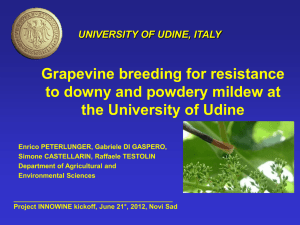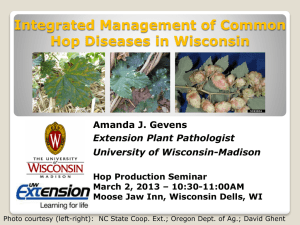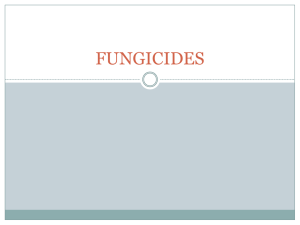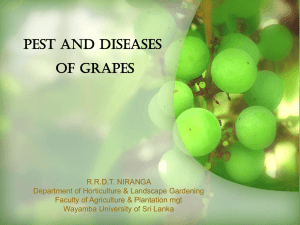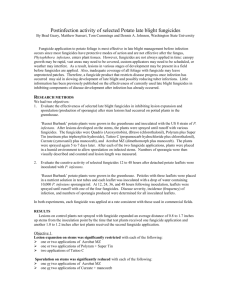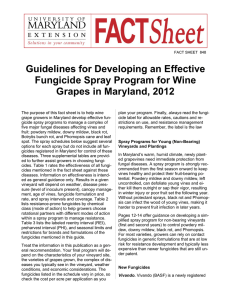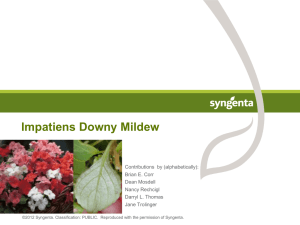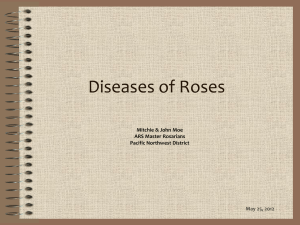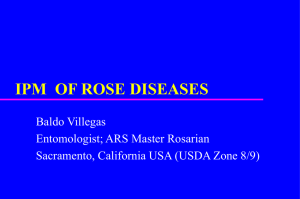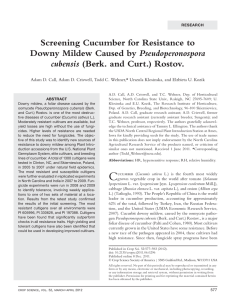Developing a Spray Program – Steve Jordan
advertisement
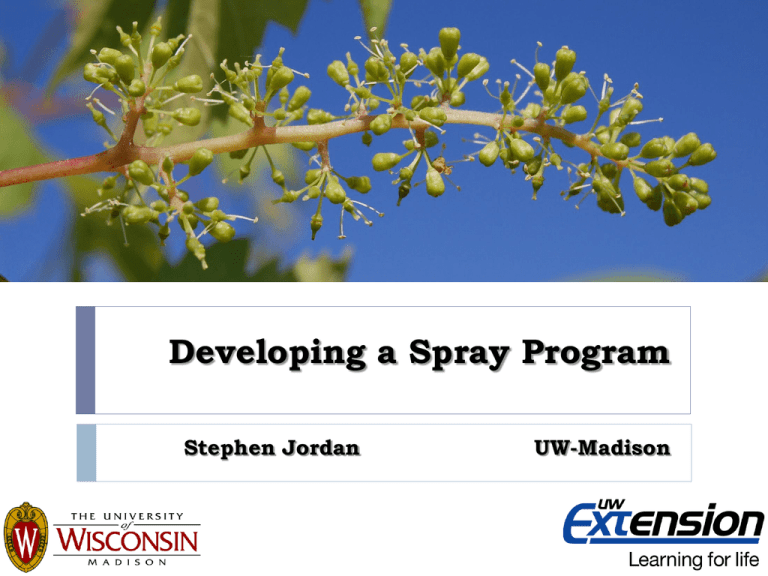
Developing a Spray Program Stephen Jordan UW-Madison Considerations when developing a spray program Varietal susceptibility to disease Vineyard disease history Fungicide options Restricted Use Pesticides (RUPs) Organic Certified pesticide applicators or persons under their direct supervision http://ipcm.wisc.edu/Default.aspx?alias=ipcm.wisc.edu/pat Organic Materials Review Institute (OMRI) Environmental impact Fungicide resistance management Cost vs product efficacy Re-entry Interval (REI) and Pre-harvest Interval (PHI) Variety Susceptibility Variety Black Rot Downy Mildew Powdery Mildew Phomopsis Anthracnose Botrytis Sulfur sensitive Copper Sensitive Brianna ++ + + ? + ++ NO ? Edelwiess ? ++ ++ ? ? ? ? ? Frontenac ++ + ++ + + ++ NO ? Frontenac Gris ++ + ++ + + ++ NO ? LaCrescent ++ ++ ++ + + + ? ? LaCrosse +++ ++ ++ ++ + +++ ? ? Leon Millot + + ++ + + +++ YES ? Marechal Foch ++ + ++ + ++ + YES ? Marquette ++ + + ? ++ +++ ? ? St. Croix ? ++ ++ ? + ++ ? ? St. Pepin + +/++ +++ + + ++ NO NO Valiant ? +++ +++ ? +++ ? ? ? +=slightly susceptible or sensitive; ++=moderately susceptible or sensitive; +++=highly susceptible or sensitive; No=not Most of these ratings were taken from research and observations from other states Unsure about a variety? talk to someone nearby who is growing it Resistant? Yes. Immune? Probably Not! Protectant and Systemic Fungicides Protectant fungicides act as a barrier to infection on the surface of the tissue Must be applied prior to inoculum reaching the vine Does not protect new growth and must be re-applied Prone to environmental degradation Rain, UV etc.. Systemic fungicides enter the plant tissue Varying levels of penetration Varying levels of “curative” power (dose dependent) Can act as a protectant Limited protection of new growth after application Less prone to environmental degradation Fungicide Resistance Management Multi-target mode of action vs single target mode of action Fungicide Resistance Action Committee (FRAC) code on labels (not all!) Mix at-risk materials with materials that have different modes of action Alternate at-risk materials with materials that have different modes of action (different FRAC codes) Avoid using low rates with marginal control. Get complete coverage so that all parts of the plant receive an effective dose. Anne DeMarsay, PhD FRAC Code FRAC Code Mancozeb Dithane, Dithane DF Rainshield , Manex II, Manzate, Penncozeb ethylene(bis) dithiocarbamate (EBCD fungicide) Broad spectrum protectant, no worries about resistance Workhorse of early-season disease control 66 day Post-harvet Interval (PHI) 24 hr Restricted Entry Period (REI) Alternatives to mancozeb Captan Can be used later in the season than mancozeb (0 day PHI) Protectant 3 day REI can make working in the vineyard a problem 24 lb/acre/year limit Can not be used with crop oils Ziram Protectant 48h REI, 21 day PHI Great for black rot Overall less effective than mancozeb Sterol inhibitor fungicides The other work horse Also known as DMI fungicides Systemic, excellent post-infection activity (“kick-back”) requires fungicide resistance management Relatively affordable Highly effective against black rot and powdery mildew, effective against phomopsis Rally (Nova) (myclobutanil) 24h REI, 14 day PHI Elite (tebuconazole) 12h REI, 14 day PHI Strobilurins Very effective, great protectant activity, poor “kick-back” activity Slightly systemic Tend to be more expensive Must use fungicide resistance management (no more than 2 applications in a row, and do not rotate with another strobilurin) Limited to 3 applications in a season (at max label rate) Strobilurins Abound (azoxystrobin) Sovran (kresoxim methyl) 12 hr REI, 14 day PHI Pristine (pyraclostrobin + boscalid) 4 hr REI, 14 day PHI. 12 hr REI, 14 day PHI, 5 day REI when cane tying, turning, girdling Potentially phytotoxic to labrusca Flint (trifloxystrobin) Less effective Mefenoxam Ridomil formulations with mancozeb, copper Expensive Very effective for downy mildew control Very systemic, curative With copper, effective against powdery mildew (but PHI of 42 days) Sulfur Sulfur is very effective for powdery mildew control Can be mixed with most other fungicides except crop oils Does not work well below 65°F and can be phytotoxic to vines at temperatures over 85°F Some cultivars are sulfur sensitive (Foch) Ask your winemaker Coppers Several different formulations (copper sulfate, copper hydroxide) Cool temperatures can lead to phytotoxicity Work well in controlling downy mildew infections, ok control of powdery mildew Only use on copper-tolerant cultivars Ask your winemaker Phosphonates Phosphorous acid fungicides Agri-fos (potassium phosphate) Aliette (fosetyl-Al) Phostrol, Prophyt (Na, K, NH3 phosphites, phosphorous acids) Work very well against downy mildew (good products for cleaning up foliage), some efficacy against other grape pathogens, Broad spectrum fungicides (?) Other fungicide options Vangard, Elevate, Endura, and Rovral Quintec Effective for powdery mildew, anthracnose, not effective for black rot and downy mildew control Quadris Top, (new product for grape) Powdery mildew product, protectant Topsin M Most effective for Botrytis bunch rot control Mix of an SI fungicide and a strobilurin Revus Top (new product for grapes) Mix of mandipropamid and difenoconazole (SI fungicide) University efficacy trials show excellent control of black rot, downy and powdery mildew Other fungicide options Crop Oils (JMS Stylet Oil, Saf-T-Side, etc) Biologicals Serenade, Sonata May play a role in organic production, not as effective as conventional fungicides Potassium Salts Effective for powdery mildew control and some insects Can remove the “bloom” from berries, not advisable for table grapes Armicarb, Nutrol Some efficacy for powdery mildew only, short-lived protectants Hydrogen Peroxide (Oxidate) Surface anti-sporulant, not a protectant Approximate fungicide costs/acre (2010) Broad Sprectrum Protectants ZIRAM 76 PENNCOZEB CAPTEC 4L CAPTAN 50W/MF Cost ($)/Acre High Low Rate Rate 12.00 16.00 8.04 21.44 10.75 21.50 10.82 21.64 SI Fungicides ELITE 45 WP RALLY 14.37 15.19 23.95 Strobilurin Fungicides SOVRAN ABOUND FLINT 18.00 24.08 25.54 27.00 37.32 51.08 PRISTINE 25.95 40.54 Phosphonates PHOSTROL Cost ($)/Acre Low High Rate Rate 11.01 22.01 Copper KOCIDE 3000 CHAMP 7.64 10.50 17.83 21.00 3.34 2.77 70.96 16.70 18.25 177.40 13.95 12.87 14.89 23.45 27.90 37.58 42.91 44.67 46.90 Sulfur KUMULUS SULFUR MICROFINE LIME SULFUR (Dormant) Others TOPSIN M RIDOMIL GOLD MZ OXIDATE SERENADE MAX VANGARD Red = OMRI approved Spray program options No spraying Prepare to be disappointed Calendar Schedule Fungicide application every x number of days Phenological Schedule Sprays are based on the growth stage of the vines 10-14 day intervals is the norm In areas with high disease pressure and susceptible varieties, this could be every 7 days Can be problematic with vines at different stages Ideally, we would use a combination of the calendar and phenological schedules with a large dose of flexibility Non-bearing vs bearing fruit Dormant spray Recommended for anthracnose, phomopsis and some insects Might decrease powdery mildew inoculum Lime sulfur Won’t eliminate the disease from your vineyard Caustic (hard on sprayer) Expensive when used as a dormant spray Does not store well (crystallizes, need hot water to mix) Stinks! Is anthracnose and phomopsis a problem in your vineyard? Yes, Apply lime sulfur No, Save your money 1” Shoots to pre-bloom 1” Shoots to pre-bloom Goal is to protect the young, growing shoots Black rot, powdery mildew, anthracnose, Phomopsis, downy mildew 14 day spray intervals should be adequate Use a good protectant such as mancozeb or captan Black rot problems or variety susceptibility, use mancozeb Downy mildew problems, use captan If you miss a spray, or wet weather is delaying a spray, add an SI fungicide (Rally, Elite, etc…) to the tank mix for “kick-back” or post-infection activity Pre-bloom to 5-6 weeks post-bloom Immediate prebloom through 5 to 6 weeks post-bloom is the most critical period for fungicide sprays Pre-bloom to 5-6 weeks post-bloom Pre-bloom to 5-6 weeks post-bloom Primary goal is to protect the young, susceptible fruit 3 sprays should cover this period (14 day intervals) we want the rest of the vine to be protected as well mancozeb or captan + SI fungicide (captan for the last spray?) strobilurin in the rotation Rainy, warm weather and susceptible variety, shorten to 10 days (strobilurin more rain fast) Don’t rely only on a strobilurin fungicide during this period 3 applications total for the season, only 2 sprays in a row fungicide resistance management 5-6 weeks post-bloom to harvest (and beyond) 5-6 weeks post-bloom to harvest (and beyond) Fruit should now be resistant to most pathogens Powdery and downy mildew on foliage Bunch rots How much disease can you tolerate Reduce over-wintering inoculum Botrytis, sour rot, ripe rot Switching from mancozeb (66 day PHI) to captan as primary protectant Typically, a drier late summer can help you reduce # of sprays Strobilurin fungicides are good for powdery mildew, downy mildew and bunch rots Example program – vines bearing fruit 1” shoots, May 1st , mancozeb ($20) 6” shoots, May 15th mancozeb ($20) Prebloom/bloom, June 1st mancozeb + SI ($35) 1st Cover Spray, June 15th strobilurin ($40) 2nd Cover Spray, July 1st captan + SI ($35) 3rd Cover Spray, July 15th strobilurin ($40) 4th Cover Spray, (veraison) Spray August 1st, captan ($20) Clean-up Spray for downy mildew in September, Phosphorous Acid ($20) Total cost per acre in fungicides - $230 Fungicide program for non-bearing fruit Not worried about fruit or harvest, so PHI goes out the window Grow tubes are an ideal environment for disease Scout for foliar symptoms Warm and humid Downy and powdery mildew are the greatest threat Anthracnose, black rot, and phomopsis may have come in on the nursery stock Spray as needed What I would keep in my fungicide storage shed mancozeb and captan A sterol-inhibitor fungicide Effective for both powdery and downy mildew Good for late season control of bunch rots Perhaps a Phosphorus acid fungicide (Phostrol, Prophyt, etc..) Rally, Elevate, etc… Tank mix with one of the above protectants during the “CRITICAL PERIOD” A strobilurin or strobilurin containing product mancozeb for early season, captan for late season Good for downy mildew on the leaves and affordable A powdery mildew fungicide What about insects? Scouting is critical Scouting for phylloxera at the end of May Insecticides are applied as needed with scheduled fungicide sprays 2011 Midwest Small Fruit and Grape Spray Guide is a great reference Phylloxera insecticide trial - 2010 Number of galls per leaf 42.6 $27 All foliar applications 2x after bloom 36.7 29.7 $17 16.2 $28 9.3 6.5 $55 3.9 Making tank mixes Fill the tank ¼ - ½ full and begin agitation When mixing chemicals, add in the following order: 1. 2. 3. 4. 5. 6. Wettable Powders Dispersible Granules Flowables Emulsifiable Concentrates Solutions Crop oils or surfactants The mixture should be agitated after each addition. Reminders for proper tank mixing Familiarize yourself with the adjustments specific to your sprayer, not all sprayers operate the same and are adjusted differently Be sure the sprayer is parked on a level surface Know the exact tank volume Mark the tank volumes where they can easily be read Calibrate the sprayer Choose a formulation that best meets the need of a particular application Read the label and be aware of mixing precautions and personal protection equipment Mix only what is needed for that day Fill half the tank with clean water, never add concentrated chemicals to an empty tank Start the agitation before adding any chemicals Reminders for proper tank mixing To avoid back-siphoning of chemicals, there should be no direct connection between the water source and the sprayer tank Properly measure and add the chemicals to the tank If using different formulations, follow the mixing order above Sometimes it is easier to premix the chemicals into a slurry before adding to the tank Rinse any mixing containers and pour the rinsate into the tank Fill the tank to its final volume, avoid over-filling the tank Properly dispose of all empty pesticide containers Properly clean-up and dispose of any spilled chemical or pesticide solution Apply the pesticide according to labeled directions Stephen Jordan 608-228-6932 sjordan3@wisc.edu

